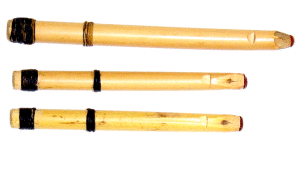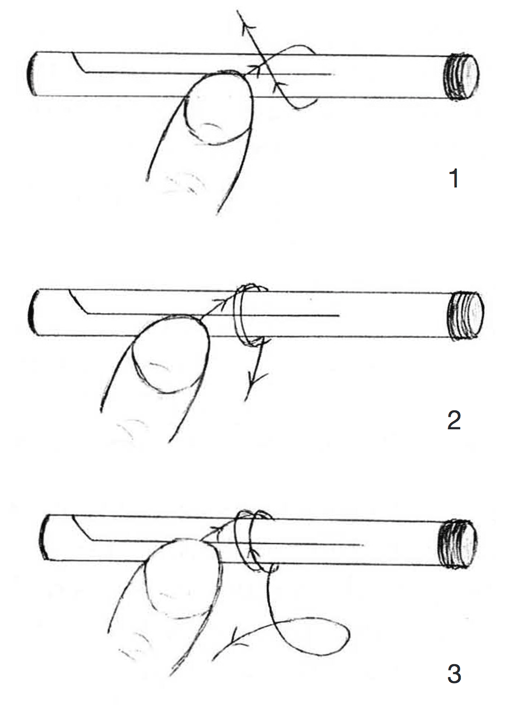Reed expert and professional maker Chris Apps continues with his monograph on cane drone reeds and addresses further problems that can be encountered with them….
Dealing With Cane Drone Reeds Part 2
by Chris Apps
 The Reed Squeals
The Reed Squeals
There can be more than one cause of this problem:
a) The bridle is too tight. Re-tie the bridle a little looser and test again (there are instructions for tying bridles later in this article).
b) The tongue is too heavy. It may be found that the tongue has too much cane on it and needs to be made lighter in order for it to vibrate freely. This is similar to a chanter reed that is tight and won’t vibrate properly.
Take a round file and file away some cane from the inside of the reed. This can be carried out from either the open end of the reed, holding the tongue down as it is filed or by sliding the bridle back and gently lifting the tongue so that the filing can be carried out directly on the underside of the tongue. It is important to not remove any material from the hard outer shell of the reed as this gives it its vibrancy and tone and resists moisture.
 c) The tongue of the reed is curved too far up, or curves up away from the main body of the reed suddenly rather than evenly. This can be easily cured by moving the bridle back towards the open end of the reed, lifting the tongue and sliding under it a small piece of folded paper under the point at which the tongue is too curved. Pressure can now be applied to the top of the tongue with the thumb and it can be bent back the other way. The bridle can now be pulled back to its previous position and the reed re-tested.
c) The tongue of the reed is curved too far up, or curves up away from the main body of the reed suddenly rather than evenly. This can be easily cured by moving the bridle back towards the open end of the reed, lifting the tongue and sliding under it a small piece of folded paper under the point at which the tongue is too curved. Pressure can now be applied to the top of the tongue with the thumb and it can be bent back the other way. The bridle can now be pulled back to its previous position and the reed re-tested.
The Reed is Rough and Unstable
There could be two explanations for this:
a) The first may be that the reed has been sprung too far open. This can be remedied by pulling the bridle back toward the open end of the reed, holding the tongue open either with fingers or with a piece of folded paper and bending the tongue back towards the main body of the reed. This is the same technique as used if the reed is squealing but the point at which the paper is placed must be as close to the bridle as possible.
b) The bridle has been tied too loosely and must be re-tied with the correct pressure. The importance of proper bridle tying cannot be overstressed. The bridle acts as a stop for the vibrations running down the tongue, which is the mechanism by which the sound is produced. This must be an efficient definite stop. If the bridle has been tied too loosely the effect of the vibration will effectively be ‘dampened’ and will not provide the crisp warm sound that is required.
Also, because the length of the tongue determines the pitch of the reed, if the vibrations do not end at a specific point the pitch will tend to vary easily with slight changes in pressure. If the bridle is overly tight, the reed can squeal as mentioned previously. Tying bridles must be done with either waxed or rosined hemp or an equivalent material that is resistant to moisture. It must have resistance to moisture as a bridle tied with dry hemp will tighten up
as the pipes are played causing changes in the sound of the drone.

To tie a bridle, tie a clove hitch round the reed then wrap two or three turns of hemp around it and finish with a further clove hitch adjusting for tension as you make the knot. The bridle must be moveable but not too tight. It is important to be aware that unlike plastic reeds, cane needs a certain amount of moisture getting to it in order to function properly. If played through a modern bag with a moisture control system which dries the air out too much some problems with stopping can be experienced. If this is the case try to allow more moist air through to the reeds.
It is easy to fall into the trap of only concentrating on the sound of the chanter and being content with the drone sound so long as they work and stay in tune with the chanter. This can result in the pipes being made up of two separate instruments, a drone sound and a chanter sound. When set up correctly the drones and chanter should blend together and compliment each other to produce a fully integrated sound.
[wds id=”19″]




















Recent Comments